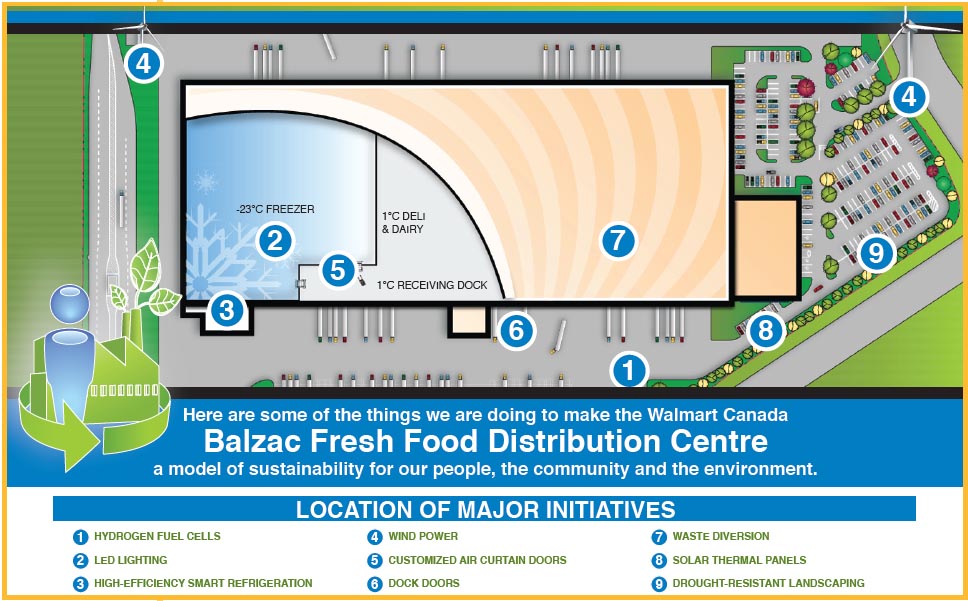Case Studies
Browse proven green business case studies from Canada by industry sector.
ShareGreen is open to everyone. Feel free to make comments on the case studies or submit one of your own. Submit a case study.
Contact:
[email protected]
Manufacturing
Walmart Canada's Balzac Fresh Food Distribution Centre: A Living Lab of Sustainablitiy
- Jun, 17 2013
- Industry Sector:Manufacturing

Challenge
Walmart’s vision is to demonstrate environmental leadership by reducing the ecological impact of its operations through company-wide programs focused on waste, energy and products, as well as outreach programs that preserve and enhance local environments. Walmart’s global goal is to generate zero waste, to be powered 100 percent by renewable energy and to sell products that sustain people and the environment.
On the way to achieving those goals, Walmart set the equally ambitious goal of building the most sustainable distribution centre possible, while at the same time delivering a compelling return on investment.
Enter the Balzac Fresh Food Distribution Centre – a living lab that demonstrates sustainable operations, products and technologies, while showing that environmental sustainability can go hand-in-hand with business sustainability.
Strategy
Walmart Canada invested $115 million to build the 400,000 square foot centre. One of Canada’s largest refrigerated buildings, it serves as a hub for fresh and frozen food destined for over one hundred of the company’s stores in Western Canada, from Manitoba to British Columbia.
Some of the distribution centre’s sustainability features include:
Hydrogen Fuel Cell Technology
In keeping with its long-term environmental goal, to be supplied 100 per cent by renewable energy, Walmart Canada will test the use of hydrogen fuel cells for the first time. Hydrogen fuel cells produce only heat and water as by-products and will replace traditional lead acid batteries in the centre’s entire material-handling fleet. Fuel cells will increase productivity and reduce operational costs because they last longer, do not need to be changed and can be refuelled in three minutes. Hydrogen will come from Quebec, where the element is produced using 98 per cent renewable energy sources, particularly hydroelectricity. Powering the material-handling fleet with fuel cells will reduce greenhouse gas emissions (GHG) by an estimated 530 tonnes.
Solid-State Lighting
In a first for a refrigerated distribution centre, the entire facility will be lit exclusively by low-energy solid-state (LED) lighting. LED lights operate at low temperatures, have long life spans and strike instantly, providing important operational and environmental benefits in a refrigerated building. Using LED lights is expected to half the energy bill for lighting and save an estimated 1,400,000 kilowatt hours annually or the equivalent of powering 121 average size Canadian households with power for a year.
Solar and Wind Energy
Walmart Canada plans to test solar and wind energy at the Balzac facility. Sixteen solar thermal panels, mounted on the side of the centre, will supply clean, renewable energy to heat hot water for the facility. A 225-kilowatt wind turbine on-site will produce enough energy to supply 55 average size Canadian homes with energy.
Energy-Efficiency
Operating a large refrigerated building requires a large amount of energy. Walmart Canada has carefully evaluated its purchasing decisions, improved building design and made technology choices to make the facility more energy-efficient. The company undertook a state-of-the-art infrared scan of an existing refrigerated distribution centre in Ontario, identifying areas that could be made more energy-efficient in the new centre. Key features of the Balzac facility include a leading-edge refrigeration system requiring significantly less power, high-efficiency doorways between temperature zones, upgraded seals throughout the building and a white roof membrane that deflects an estimated 85 per cent of sunlight to reduce heat gain and demand on the electrical grid.
Sustainable Construction
Environmental sustainability is an important part of the construction phase, now underway. Through innovative waste diversion strategies, Walmart Canada expects to divert as much as 50 per cent of its construction waste from landfill. The entire construction phase will also be powered by renewable energy through Bullfrog Power, a Canadian provider of low-impact renewable electricity.

Result
The facility is an estimated 60% more energy-efficient than company’s traditional centres and will help avoid approximately $4.8 million in energy costs over 5 years.
The Balzac distribution centre is not only about reducing Walmart’s own environmental footprint and making strides to achieve their long-term sustainability goals, it’s about leading change across an industry and the business world at-large. The hope is that in the future, facilities like this will no longer be demonstration facilities but instead the norm for the industry.





Post new comment